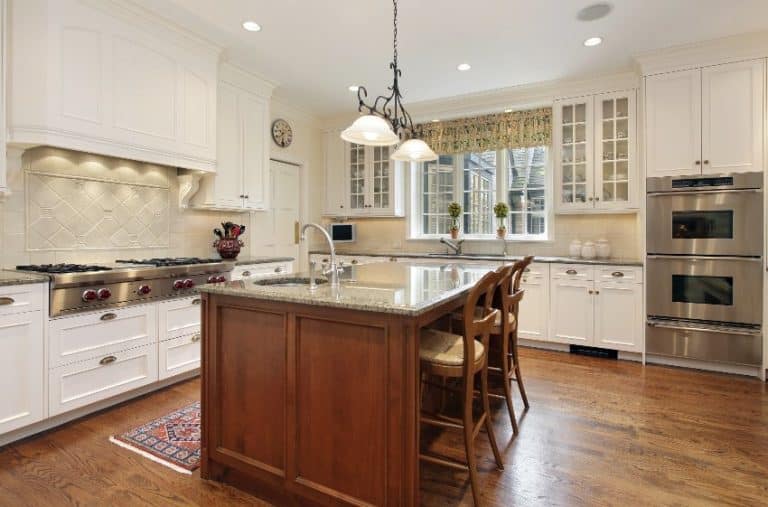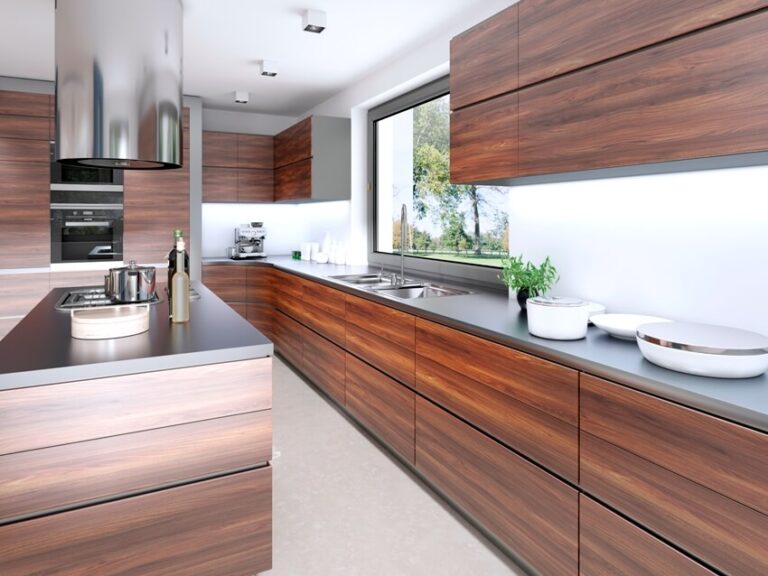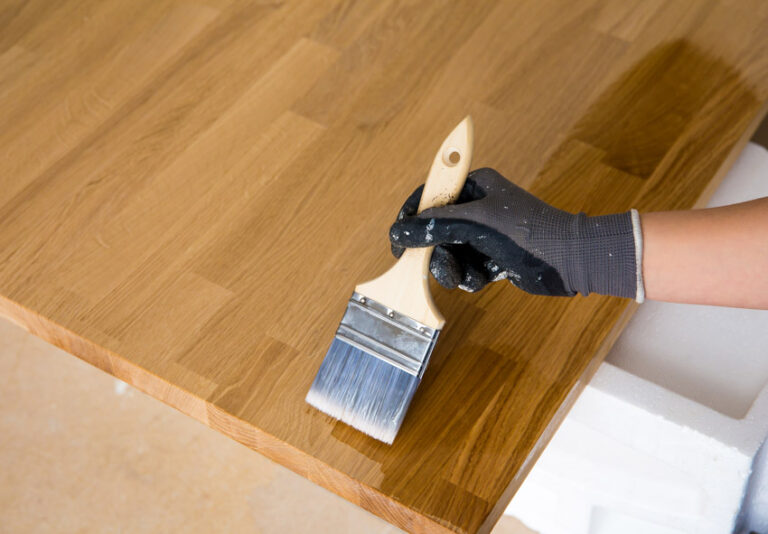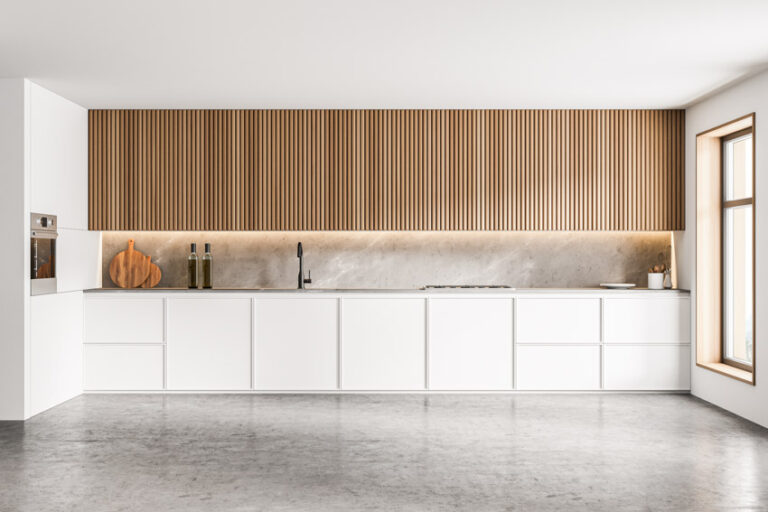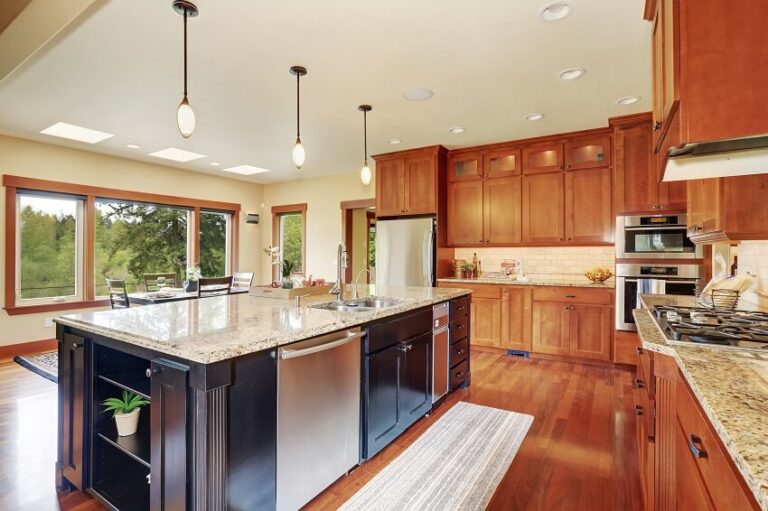Recycled Glass Countertops (Pros and Cons)
Find out all about recycled glass countertops, including what they are, the pros and cons, the different types, kitchen designs, their durability, their cost, and their recycled glass cleaning tips.
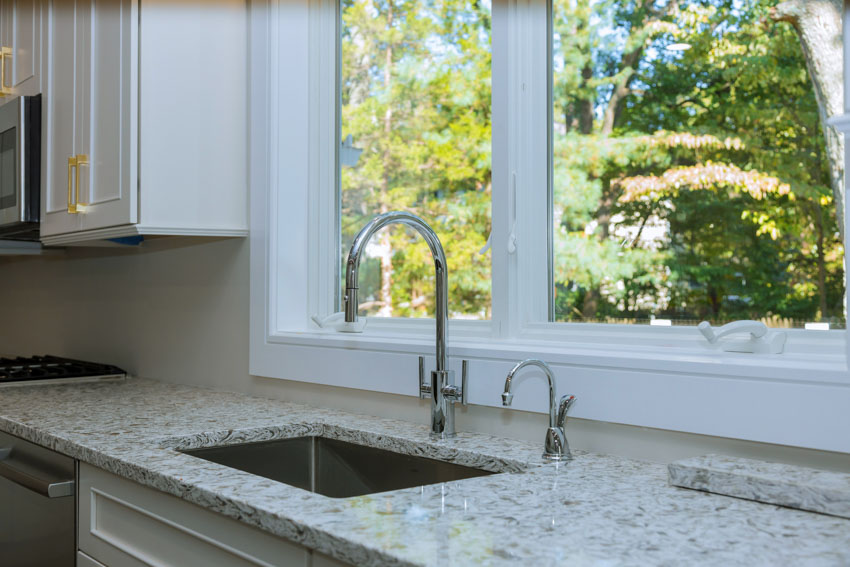
Stone countertops are widely used because they can withstand different kitchen tasks and abuse, but there is another option to consider, which is recycled glass countertops.
These are long-lasting, simple to clean, and appealing. Since it is reusable, glass is recognized as an environmentally beneficial material. It is one of the most durable man-made elements.
Finding ways to recycle and repurpose shattered glass is a crucial component of a healthy home. Truly, one practical technique to transform something that’s broken into a useful and visually beautiful kitchen centerpiece is to use them as countertops.
You can be environmentally conscious while also displaying your distinctive personality. With a plethora of colors to pick from, you are sure to discover the perfect shade to add bright, dramatic shades, or more subtle colors to your kitchen or bathroom.
What Is a Recycled Glass Countertop?
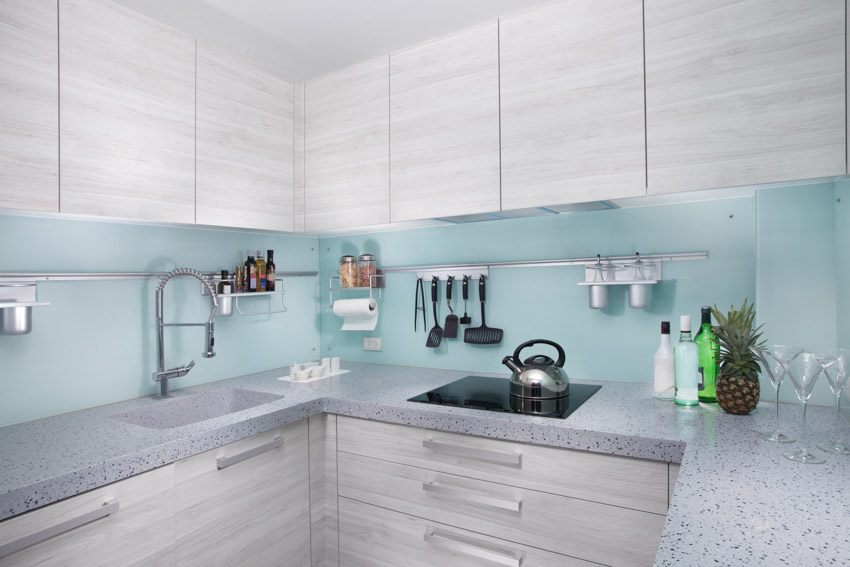
Manufacturers generally employ resources from curbside resource recovery and demolished structures. The material is combined with resin or concrete binders to create a slab that can be used as a countertop.
To provide structural strength, it is often enclosed in a cement or petroleum-based binder. In most situations, the end product contains between 70% and 85% of recycled products.
Most recycled glass countertops have a vibrant mosaic of shards lying in the binding substance. There are also uniform recycled glass countertops available on the market. Fabricators melt down glass from different sources to form a slab for manufacturing these.
Upcycled Glass Kitchen Surface Pros and Cons
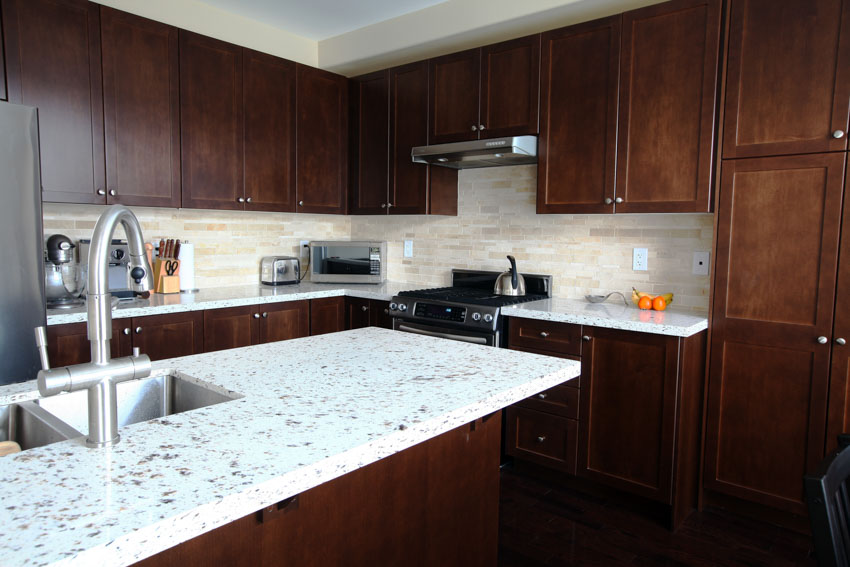
Pros of Repurposed Glass Kitchen Counters
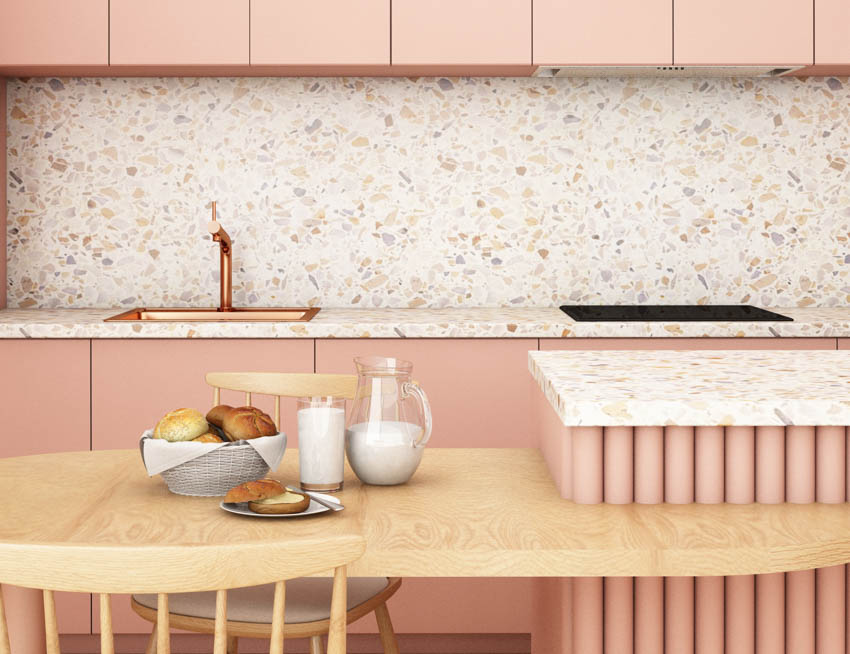
Very Environmentally Friendly: Using repurposed bio-glass within our homes is unquestionably a sustainable activity. It is sad to say that, in 2017, the United States produced 569 million tons of demolition and construction detritus. 90% of that garbage is generated by the destruction of old buildings.
Every year, glass detritus is estimated to account for 11.4 million metric tons of waste. Glass waste, from old window panes to glass containers, frequently winds up in the garbage and, later, in local dump sites.
These countertops, on the other hand, are made from materials that came from both household and economical recycling, as well as materials from construction demolition operations that would otherwise wind up in the landfill.
The majority of finished recycled glass countertops include around 70% to 80% recycled material. One of the most significant advantages of these countertops is their ecological sustainability, which makes them the embodiment of the line that states, “trash becoming treasure.”
Indeed, these countertops help to keep unwanted debris out of dumpsites, where it takes 1 million years to decompose. Common types of kitchen countertops are usually 30 square feet in size.
Think about this – we can recycle all of the broken glass into approximately 4 billion square feet of gorgeous countertops in the United States, which has roughly 138 million housing properties.
If Properly Maintained, Recycled Glass Countertops Can be Extremely Durable and Long-Lasting: When properly produced and maintained, these countertops can be very durable and will endure for years with proper upkeep.
However, it is critical to start with the best quality you can find. Professional makers must set the glass in a cement or petroleum-based material mix to establish the structural integrity of the glass countertop.
You will, nevertheless, wish to extend their service to your kitchen or bathroom. Therefore, you must properly protect your recycled bio-glass countertops to prevent stains or discoloration from acidic foods like citrus or vinegar.
Heavy cookware and related items, if put dangerously close to the edge, may shatter the countertop. Furthermore, you must ensure that your recycled glass countertops are built of non-toxic materials in order to keep your food safe to eat.
Unique Countertop Option: Marble, quartz, granite, and ceramic all seem to be the most common countertop materials for a reason. Nevertheless, if you want a genuinely one-of-a-kind countertop that will spark curiosity, this material could be a great option that can compete with natural stone’s certain qualities.
Shattered bottle fragments are combined with a resin-based binder to create bio-glass. Such countertops are available in a multitude of vibrant hues, which will bring a modern and colorful accent to your kitchen or bathroom. Due to the way they are made, every recycled countertop would be unique, which means nobody else will enjoy the same countertop design as you.
These countertops, in fact, give a distinct appearance that traditional materials cannot match. This distinguishing appearance can offer your kitchen a modern touch, particularly when it complements certain materials, such as stainless steel.
Recycled Glass Countertops are Non-Porous: The porous nature of natural stone countertops makes them particularly susceptible to discoloration, which is one of the most frequent issues about them. Luckily, this will not be a problem for bio-glass. It will not age or stain.
Uncomplicated Maintenance: This material is simple to clean with soap and water, although those with cement-based binders should be coated consistently to safeguard the concrete binder from acidic liquids such as citrus liquids and vinegar, which might damage the surface.
Since cement-based countertops are porous, they will discolor if not sealed. Hence, they need sealing. On the other hand, resin-based countertops are non-porous and do not necessitate regular sealing, making them easier to keep clean and maintain.
Cons of Reused Glass Material Kitchen Surfaces
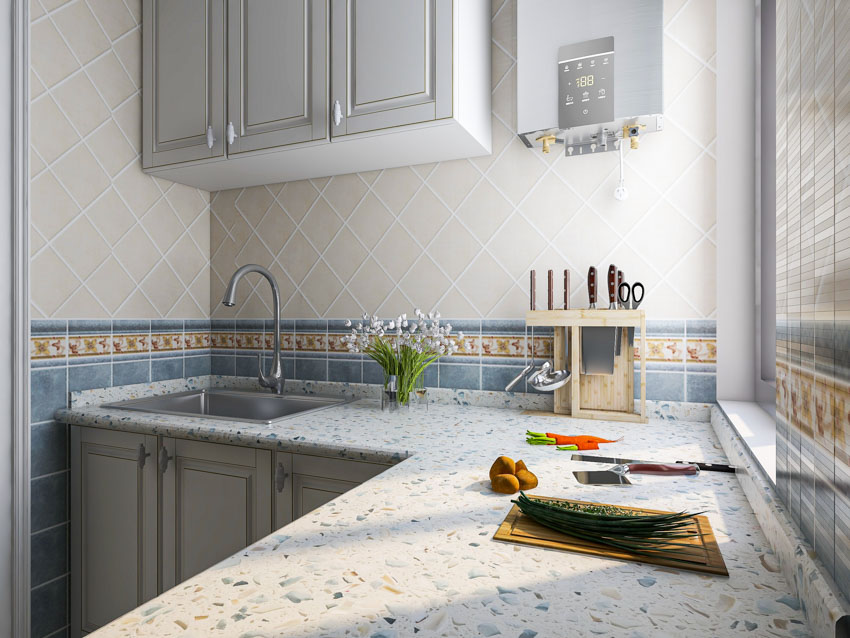
It can be difficult to coordinate the old countertop to a replacement piece, particularly if yours is a customized combination of colors. Whenever this countertop cracks, it leaves a sharp edge, which can be harmful if not handled carefully.
High-quality countertop cracks are not frequent, but they do occur at times. Since every bio-glass countertop is unique, it might be a smart idea to get a backup panel in case a piece falls off. You will be able to repair it instead of needing to completely replace the countertop.
Installation Needs Professional Assistance: A counter with this material must be installed by a specialist because of the possibility of fractures or chips. This raises the total cost of this countertop.
Experienced installers are equipped with the necessary materials and will understand how to manage seams. Breakage during transportation must also be avoided since the damage is irreversible.
Can be Expensive: Unfortunately, these countertops can be pricey, although they are usually not much more pricey than marble or granite countertops. Excluding the installation, the cost per square foot averages $80.
Moreover, contingent on the architectural complexity and labor needed, you might need to add another $30 to $80 per square foot for recycled glass countertop installation expenses.
Crushed Salvaged Glass Bar Tops
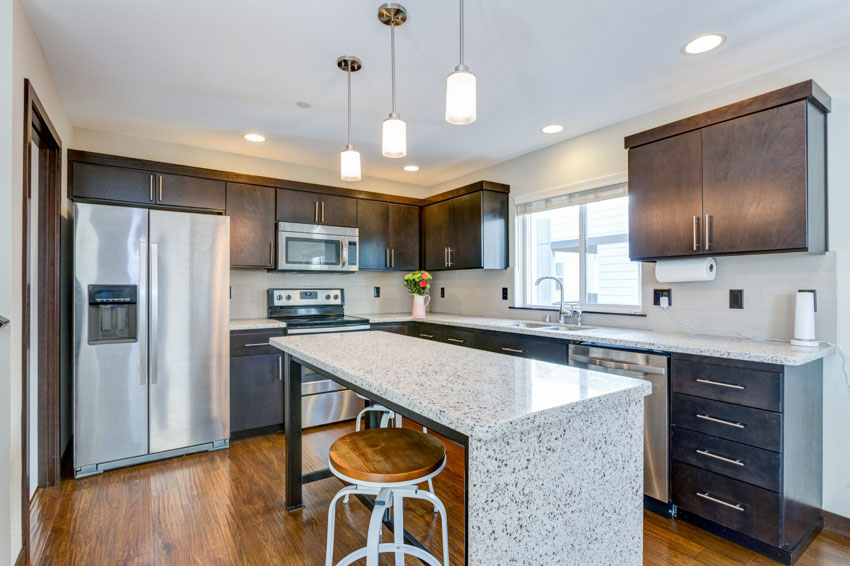
Moreover, crushed recycled glass countertops are often created by embedding crushed glass into a concrete or acrylic substrate. The result is a textured mosaic of a matrix with glass that adds a unique appearance to the surface.
Crushed glass countertops are mostly created from post-consumer glass. This implies that there will be an application for vast amounts of bio-glass that make their way into recycling operations and are not necessarily appropriately disposed of.
Crushed glass is also a very durable countertop material. As with most stones, you may cut directly on it without the risk of scratching it, and it is extremely impact-resistant.
Sea Glass Island Counters
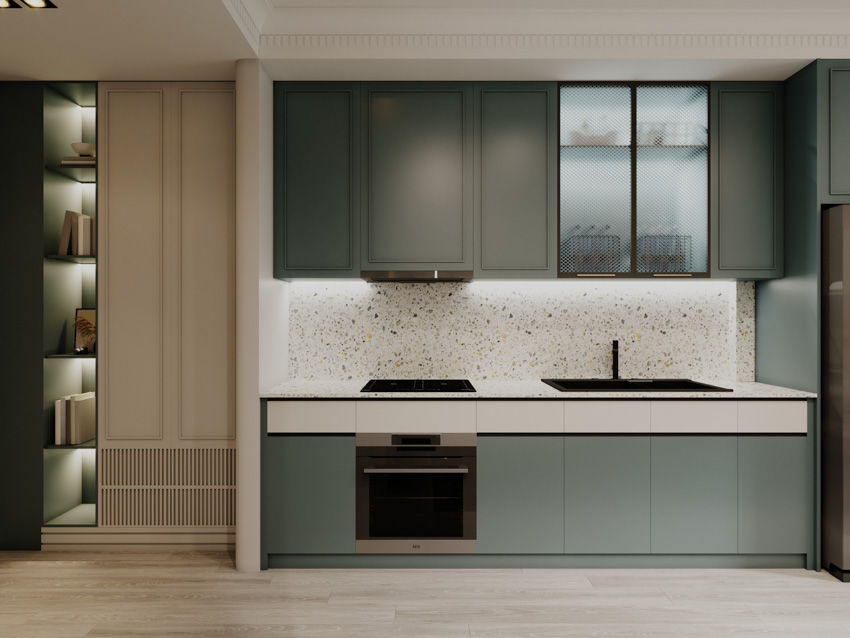
Fragments appear to come up softly from the concrete surface, with the feel of a weathered look yet the luminous appearance of a pearl, resembling bubbles emerging to the surface of sand underneath the waves. A recycled glass backsplash combined with matching countertops can blend well and make a great impression.
The capability of sea glass to be illuminated, which will artistically redefine it, is the most appealing feature to consumers. Its pure and simplistic appearance makes it ideal for a minimalist and modern setting, and its application is only restricted by your imagination. This material, like any other stone slab, can be custom-cut for countertop applications.
Terrazzo Glass Island Tops
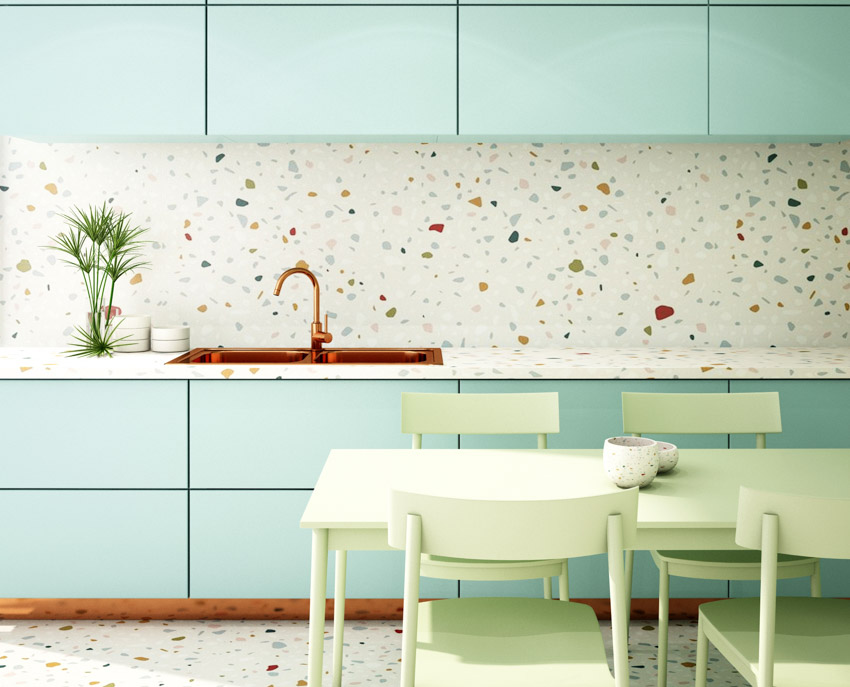
Such binding materials are usually resin or cement. The glass-to-binder proportion differs from manufacturer to manufacturer, but practically every terrazzo countertop is constructed of at least three-quarters of bio-glass chips.
Crushed glass is also used in terrazzo style as a byproduct or post-industrial debris from production and building deconstruction as well as post-consumer trash such as liquor bottles.
Terrazzo’s one-of-a-kind look may transmogrify an ecologically friendly countertop into a gorgeous work of art while also increasing the longevity of the countertop installation.
Manufacturers of terrazzo countertops have never used such bright colors before. With over 30 colors and styles frequently available, the possibilities are truly endless.
DIY Recrafted Glass Culinary Counter

Basically, all you need to do is spread a thin coating of the two-part epoxy on your preferred substrate. Distribute a medium aggregate coating over the epoxy surface and wipe off excess material.
Distribute smaller aggregate shattered glass over the panel and wipe off the excess again. Allow the epoxy countertop to harden before shaking off any unnecessary components. If you are using a glass-made substrate, you can illuminate the panels from either the front or the back.
Cement Countertops with Reclaimed Glass
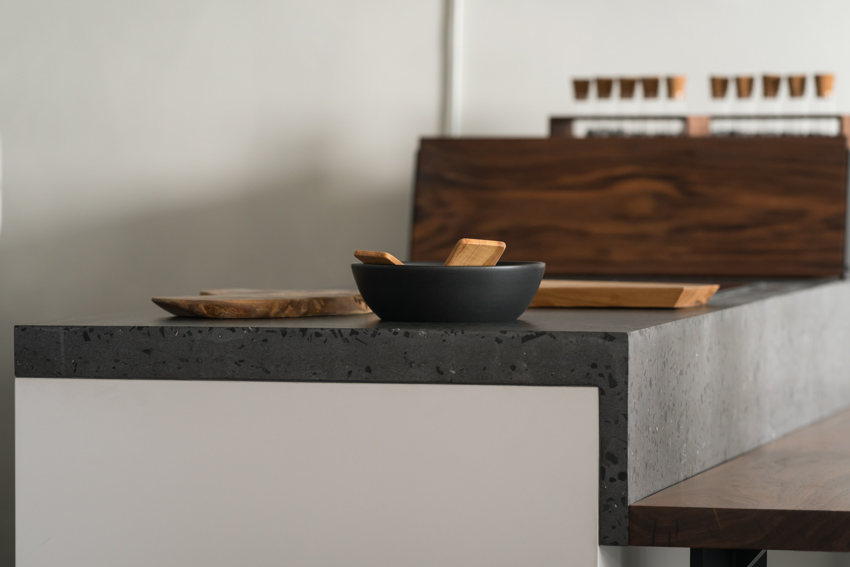
These chips can be enclosed and incorporated into cement. They can also be added to cement counters by seeding the surfaces or blending the bio-glass pieces with the cement.
Seeding is the process of scattering or sprinkling bio-glass onto the surface of cement after it has been positioned in the countertop mold. The benefits of this include using less material, and it gives you more command over the distribution of different colors and mixtures.
Are Remanufactured Glass Worktops Durable?
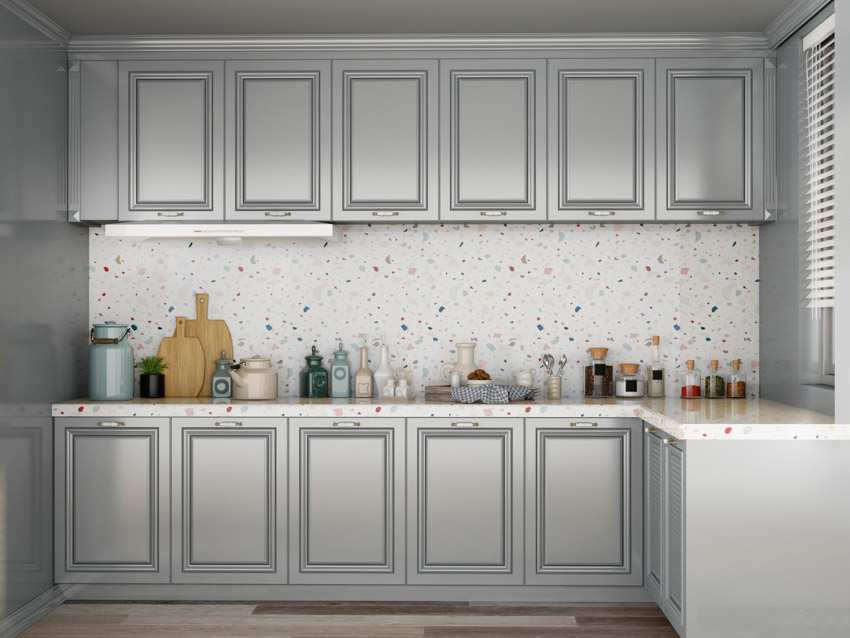
Due to the production process, these countertops are hardly prone to flaming, incinerating, or melting. That implies you may lay heated cookware on the surface without having to look for a potholder.
The only primary issue with this kind of countertop is the possibility of fractures or chips around the edges. Luckily, this issue is readily controlled by wanting to avoid positioning weighty objects near the countertop’s corners.
Recomposed Glass Culinary Top Cost
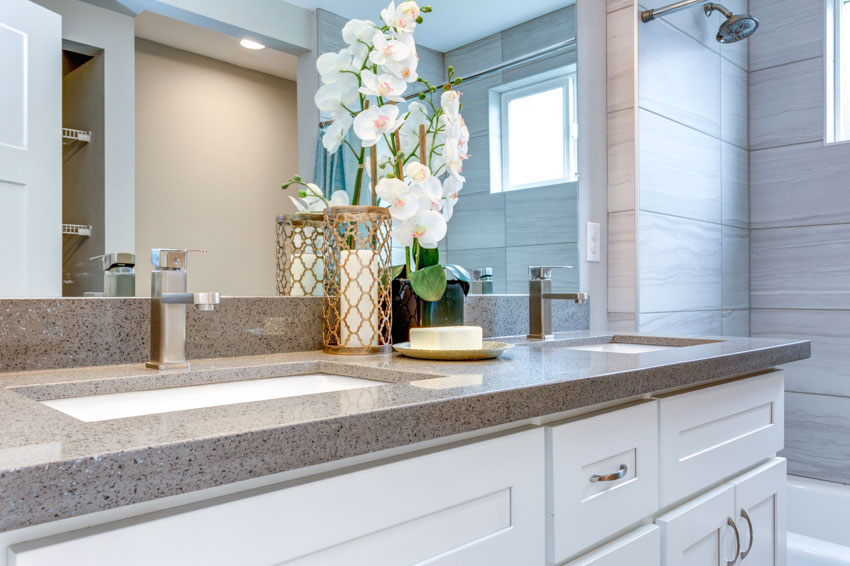
Once you severely ruin the surface, you might have to replace it entirely. However, each installation differs; thus, you should consult a reputable specialist to determine the cost more precisely.
Salvaged Glass Island Countertops Cost Vs Quartz
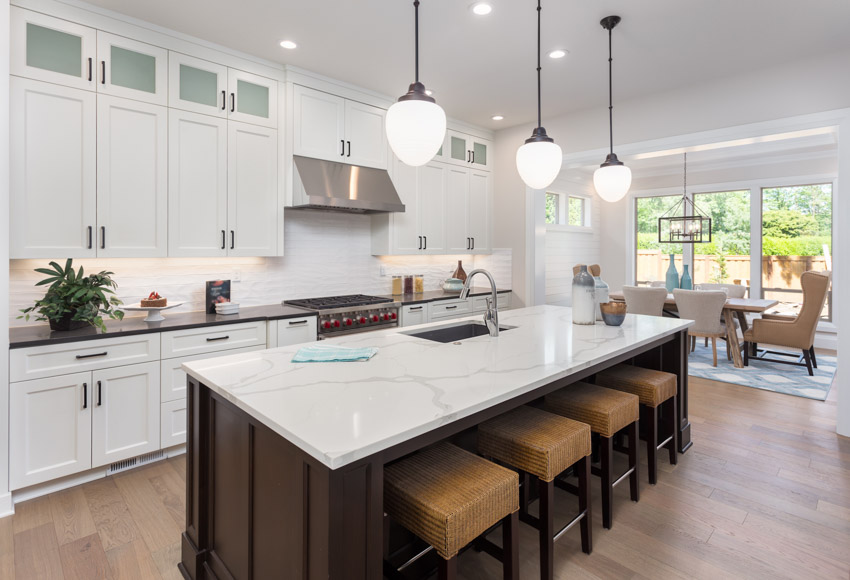
Eco-Friendly Glass Vs Quartz Countertops

Durability: This type of countertop can tolerate high temperatures without being destroyed. These non-porous counters, with appropriate maintenance, can survive for so many years without displaying indications of wear and tear.
Nonetheless, quartz is among the most long-lasting countertop materials on the market nowadays. It is not readily broken. It is indeed heat- and stain-resistant as well as non-porous, making it an excellent choice for bathrooms and counters. Countertops made of recycled materials, however, have a higher chance of getting shattered than quartz.
Maintenance: This material is incredibly simple to clean. It does not collect stains easily. To maintain a clean surface, you can simply use mild soap and water from time to time.
Nevertheless, to maintain your quartz countertop appearing at its best, you have to clean it more frequently with a light soap and water combination. You have to avoid using harsh chemicals or abrasive cleansers, which can easily harm the surface. A stronger cleaning solution may be required for stubborn stains.
Restored Glass Vs Granite Breakfast Bar Counters
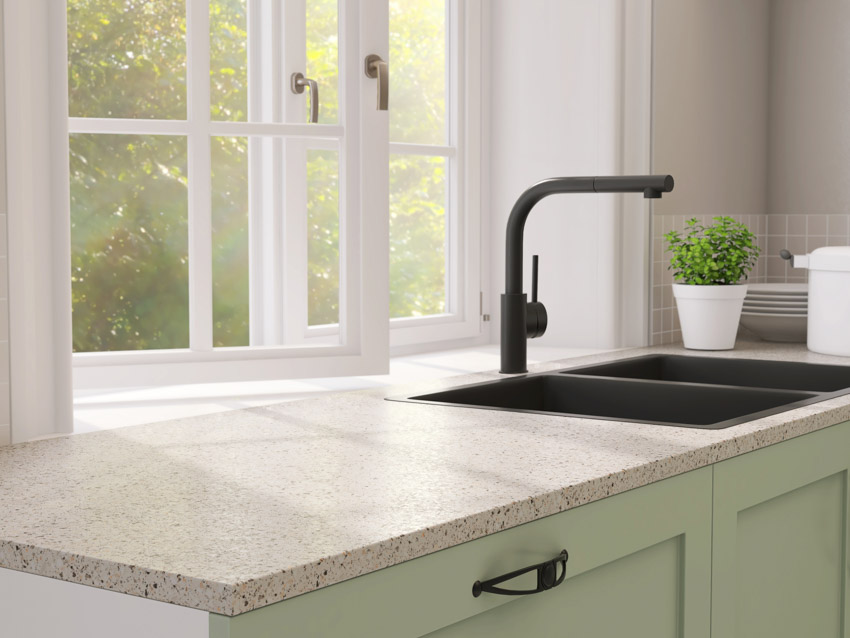
However, not all granite is mined domestically. When purchased from overseas locations, the energy needed to transport them back to the United States for purchase and installation rises considerably.
Stain-Resistance: Generally, granite is stain-resistant, although not as much as recycled bio-glass surfaces.
Maintenance: Granite is often regarded as a low-maintenance countertop option. Its sealant should last at least ten years. If a countertop is made using a cement-based binder, it needs to be maintained constantly like granite counters.
How to Clean Recrafted Glass Dining Surface
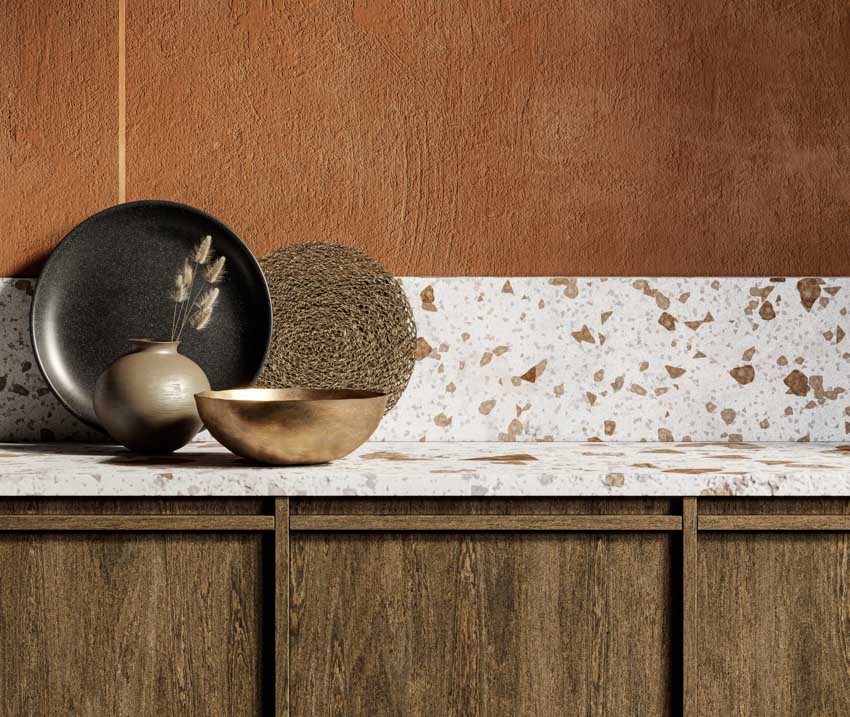
• Use any cleaner suitable for clear surfaces at any grocery store or supermarket.
• For a natural cleaner, you can use vinegar and distilled water.
• Use soap, water, and a soft cloth to remove spills and stains.
See more related content in our article about nano glass kitchen countertops on this page.


